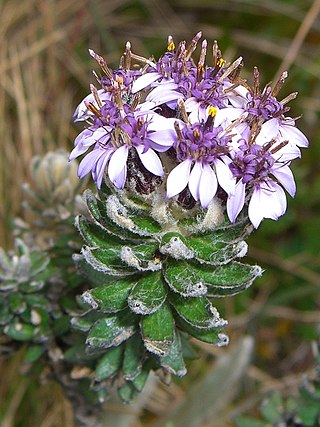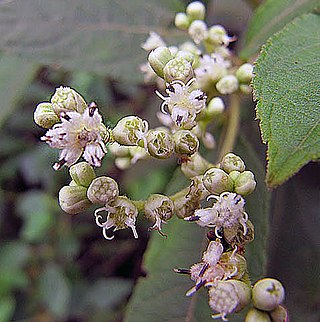
Eupatorieae is a tribe of over 2000 species of plants in the family Asteraceae. Most of the species are native to tropical, subtropical, and warm temperate areas of the Americas, but some are found elsewhere. Well-known members are Stevia rebaudiana, a number of medicinal plants (Eupatorium), and a variety of late summer to autumn blooming garden flowers, including Ageratum (flossflower), Conoclinium (mistflower), and Liatris.

Baccharis is a genus of perennials and shrubs in the aster family (Asteraceae). They are commonly known as baccharises but sometimes referred to as "brooms", because many members have small thin leaves resembling the true brooms. They are not at all related to these however, but belong to an entirely different lineage of eudicots. B. halimifolia is commonly known as "groundsel bush", however true groundsels are found in the genus Senecio.

Diplostephium is a genus of trees and shrubs in the family Asteraceae.

Clibadium is a genus of flowering plants in the family Asteraceae.
Dendrophorbium is a genus of South American flowering plants in the family Asteraceae.

Jungia is a genus of flowering plants in the family Asteraceae. It is native mostly to South America, with one widespread species extending its range into Central America and southern Mexico.

Munnozia is a genus of flowering plants in the family Asteraceae. It is centered in the Andes.

Mutisia is a genus of flowering plant in the tribe Mutisieae within the family Asteraceae. Mutisia has been named after José Celestino Mutis. It comprises about sixty species which can be found along the entire length of the Andes and in southern Brazil, Paraguay, Uruguay and northern Argentina.
Oligactis is a genus of South American flowering plants in the tribe Liabeae within the family Asteraceae.
Pappobolus is a genus of flowering plant in the family Asteraceae native to the Andes Mountains of Colombia, Ecuador, and Peru.

Pentacalia is a genus of flowering plants in the family Asteraceae. About 34 members of this genus appear to be located in the South American county Ecuador, where they are threatened by habitat loss. The genus contains approximately two hundred species, which are distributed from Mexico to northern South America.

Pseudogynoxys is a genus of flowering plant in the groundsel tribe within the sunflower family, native to North and South America.
Talamancalia is a genus of flowering plant in the family Asteraceae. It contains the following species:

Brunellia is a genus of trees. They are distributed in the mountainous regions of southern Mexico, Central America, West Indies, and South America. Brunellia is the only genus in the family Brunelliaceae. As of 2001 there were about 54 species.
Erato is a genus of flowering plants belonging to tribe Liabeae of the family Asteraceae. It is found from Costa Rica to Bolivia, with its main centre of diversity in Ecuador.

Lasiocephalus is a genus of South American flowering plants in groundsel tribe within the sunflower family. The genus was shown to be part of Senecio and predominantly occurs in tropical alpine-like regions.

Montanoa is a genus of flowering plants in the tribe Heliantheae, within the family Asteraceae.
Philoglossa is a genus of South American plants in the tribe Liabeae within the family Asteraceae.
Pseudonoseris is a genus of South American plants in the tribe Liabeae of the family Asteraceae.
Chrysactinium is a genus of South American flowering plants in the family Asteraceae.












